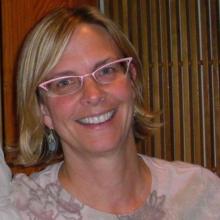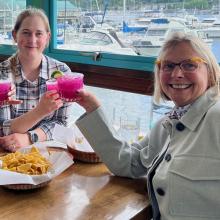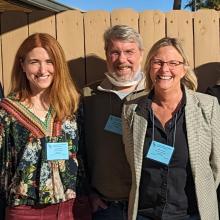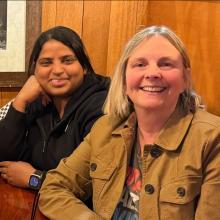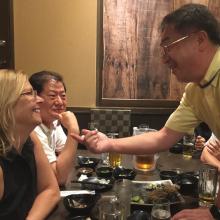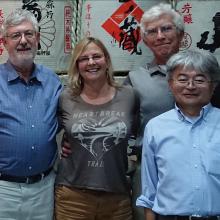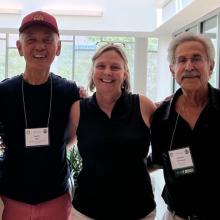As of April 1, 2025, Professor Julie Kovacs retired and was appointed Professor Emerita of Chemistry. Kovacs, an expert in bioinorganic chemistry, joined the University of Washington faculty in 1988 as assistant professor of chemistry, following a postdoctoral stint at Berkeley and Ph.D. work at Harvard. In 1994, she became the first woman in the Department of Chemistry to be promoted to associate professor with tenure. She was promoted to full professor in 2001 – again, the first woman in the Department to achieve that rank.
Kovacs' research focuses on the role of iron thiolates in promoting the biosynthesis of biomolecules important to human health. Her work has been supported by the National Institutes of Health since the early 1990s and the National Science Foundation.
“Julie’s research is rigorous, fundamental, and has had significant impact on the field of bioinorganic chemistry,” says Professor Ed Solomon of Stanford University, who collaborated with Kovacs on six studies related first to nitrile hydrase electronic structure and reactivity, and later to Fe- and Mn- oxygen intermediates.
Solomon and Kovacs first met in 1996 at an American Chemical Society (ACS) national meeting and reconnected over the years at numerous national and international conferences, where Kovacs was often a plenary or invited speaker.
“She is an outstanding conference lecturer, as her chemistry has been cutting-edge and uniquely designed to address biochemical questions,” describes Professor Kenneth Karlin of Johns Hopkins University, a longtime colleague and friend who has crossed paths with Kovacs at conferences annually since about 1990.
Karlin, whose work also lies in a subfield of synthetic bioinorganic chemistry, notes that Kovacs “presents very thorough in-depth studies, with meticulous characterization of her synthetic compounds and their reactivity, coupled with rigorous spectroscopic and physical analyses.”
“Talking science with her is always very thought-provoking and fruitful,” he adds. “She is very smart and knowledgeable and very good at answering and asking questions.”
Kovacs traces her early interest in science to childhood conversations with her father, Julius Stephen Kovacs, a theoretical physicist and professor at Michigan State University. As a child, Kovacs’ father engaged her in conversations about conservation of angular momentum, and the relationship between a magnetic field and electrons traveling through a Cu coil. They hiked Flattop Mountain together in Colorado numerous times where he stumped her with the idea that the earth pushes back with an equal but opposite force, until her father explained that mass enters into the equation. This was the beginning of her curiosity-driven approach to science. As an undergraduate student at Michigan State University, Kovacs earned a bachelor’s degree in 1981, while conducting undergraduate research on iron-sulfur cluster chemistry with Bruce Averill. She went on to earn her Ph.D. at Harvard University with Richard H. Holm, a pioneer in bioinorganic chemistry, and completed a UC President’s Postdoctoral Fellowship at the University of California, Berkeley with Robert G. Bergman , one of the early pioneers of C-H bond activation.
At UW, Kovacs and her research group synthesize bio-inspired transition-metal complexes in order to learn from the design principles perfected by nature over billions of years. Their work employs a variety of spectroscopic techniques, low-temperature stopped-flow kinetics, electrochemistry, X-ray crystallography, theoretical calculations, and inorganic and organic synthesis. In her curiosity-driven fashion, Kovacs wanted to understand how a molecule’s electronic structure contributes to reactivity, so she purchased several nodes on UW's supercomputer, taught herself DFT and became well-versed in the use of the computational program ORCA. Spectroscopic methods such as EPR, low temperature electronic absorption spectroscopy, resonance Raman, and Mossbauer were applied to provide information regarding spin-state, metal ion oxidation state, and the electronic transitions responsible for enhancing a particular molecular vibration. She purchased a Mossbauer instrument, the only instrument of its kind on UW campus, in order to probe nuclear transitions sensitive to a metal ion’s electronic and geometric environment.
A major focus of her research has been on determining how cysteinates influence the function of non-heme iron enzymes . Cysteinate-ligated non-heme iron enzymes play key roles in tumor suppression, antibiotic biosynthesis, and degradation of reactive oxygen species. Yet the mechanisms by which they operate remain poorly understood.
In 2022, Kovacs was elected to the American Association for the Advancement of Science “for distinguished contributions to synthetic bioinorganic chemistry in defining the role of thiolate ligands in oxygen activation by metalloenzymes and their models.”
In addition to her research, Kovacs has made significant contributions to the field through her extensive service at the national level. She served as chair of the ACS Division of Inorganic Chemistry (2020), served on numerous NIH review panels, held roles on multiple ACS committees , and organized a wide range of professional conferences including ACS symposia and Gordon Research Conferences, for which she has served as vice chair and chair.
At the department level, Kovacs served on several faculty search committees and the Academic Personnel Committee. Throughout her 37-year career at UW, she has been a dedicated educator and mentor, known for her high expectations of her students and postdocs.
“Despite a variety of obstacles, she established a superb track record as a researcher, as a mentor, and as an educator,” says Professor of Computer Science Ed Lazowska. In the early 1990s, then-Chair of Chemistry Bob Watts introduced Lazowska to rising stars across the university – including Kovacs.
“Bob explained to Julie and me that the University of Washington was a place where nothing is easy, but anything is possible,” Lazowska recalls. “Julie exemplifies this… The University of Washington needs more Julies.”
With congratulations on this milestone and gratitude for her service, we look forward to Professor Kovacs’ continued engagement with the department in her emerita role.
